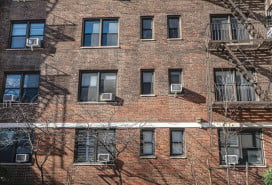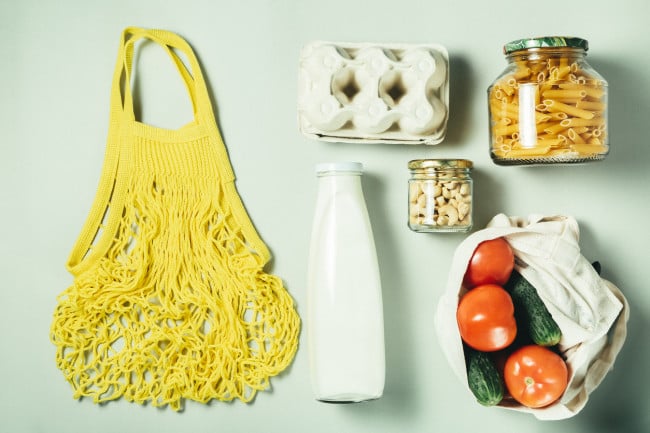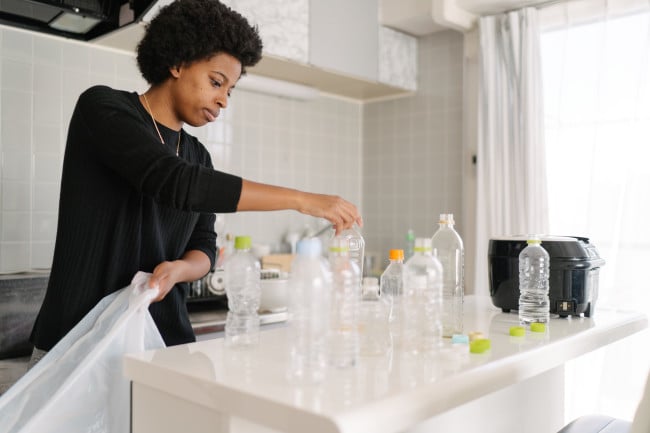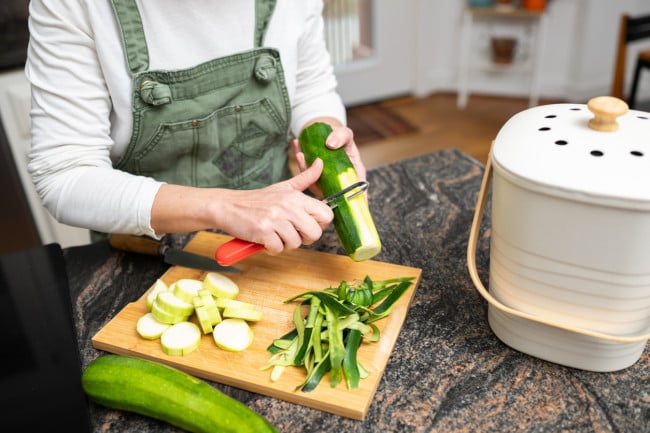Listen to me and my worm-pals: Composting is easier if you do it yourself
- Here's my take: Maintaining an outdoor composter is easier than separating organics for pick up by the city

The author's two-chambered composter with plant saucers underneath to collect beneficial "compost tea."
Jennifer White Karp
If you’re not used to separating your organics for compost collection—which will become mandatory in New York City in 2025—you probably think it is gross or overwhelming, but I’m here to tell you there is a much easier way: Get your own backyard composter.
NYC’s expansion of its free, curbside compost collection is a much-needed step in the right direction, but if you really want to make composting easy and reap the benefits, and you have the space, you can do it yourself. You don’t need a lot of room, and you don’t need to be an owner—renters can compost outside too. A composter can be had for less than $50, so it's not a huge expense.
You can compost your own veggie scraps and leaves if you live in a townhouse or small one- to four-family building. (It would likely be difficult to maintain multiple outdoor composters for a large apartment building, so using the city’s collection service would be your best bet there.)
Putting your veggie scraps in your own composter means you don’t have to 1) save them in a countertop container or in your fridge or freezer, 2) put them in an outdoor bin, and 3) put the bin on the curb on recycling day.
After all, why give up that “black gold” that could be used for your own container garden, tree pit, or community garden? Plus, if the goal is to reduce harmful greenhouse gases by diverting organic waste from landfills, burning fossil fuels to truck organic material around the city does not seem ideal.
My life in composting
I should probably explain that I’m really comfortable with composting. I grew up with parents who had a compost pile, as we called it. It was just a simple open frame made of two by fours and chicken wire, wedged behind the garage of our suburban Long Island home. Saving fruit and veggie scraps for the pile was something I didn’t think too much about, except when a guest threw a banana peel into the regular garbage pail. Then my family would lunge to retrieve it for the compost pile. I still do that today when my family members throw an apple core in the regular garbage.
More recently, I lived in a three-family rental building and the landlord had a composter like this that tenants could use—that’s when I realized NYC renters could maintain composters too, because if you have room for a garbage bin, you have room for a composter. If it is on a concrete slab or raised above the ground, you do not have to worry about rats or mice burrowing inside.
Now I rent somewhere else and have my own composter. It has two chambers, and I highly recommend this version. One side is active—that’s where I currently deposit kitchen scraps. The other side is resting, transforming into something beneficial. Every week or so, I spin it a few times to aerate it. And since it is off the ground, so I don’t have to worry about mice or rats. On the ground below, I collect compost tea, which is great for plants.
Tips for making composts collection easier
Whether you collect food scraps for your own composter or the city's collection service, you’ll find other benefits as well: You'll have less ordinary trash, and the trash itself is drier (no more wet, leaking bags) because you’re separating out things like mushy veggie scraps and the rotten fruit that you didn’t get around to eating.
Here’s what I think is the key to neat, odorless compost collection: Your freezer. I don’t bother with a countertop container, namely because I don’t have the space. I keep a medium-sized stainless-steel bowl in the freezer (your fridge would work too). If you don’t have room in your fridge or freezer for a bowl, you can put a quart-sized soup container in the fridge door.
When I’m preparing a meal, I keep my collection bowl near my cutting board and toss veggie scraps in it, and then put it back in the freezer. When the bowl is filled, I turn it over my composter and pop out my compost popsicle by giving the bowl a squeeze.
Backyard-style composters are not as efficient as a municipal operation, and the guidelines are different—your backyard tumbler will not heat up to the same degree as a giant city compost field, so you’re slightly limited in the variety of materials you can compost, but the bonus is you can make use of both. For example, I use a backyard composter for my veggie scraps and the city’s collection service for larger tree branches and weeds that I don’t want to infiltrate my plants.
You’ll also have to learn how not to kill off the beneficial microbes (don't use tap water to moisten your compost) and you need to balance the green and brown organic material—but none of this has been complicated or hard to learn. For example, I keep a second bin next to my composter full of dried leaves and try to add a couple fistfuls each time I add kitchen scraps to the composter.
What to do with your fresh compost?
One question I get a lot is what to do with all the fresh compost? Turns out, composters don’t produce a ton of material, even for a family of four that eats a lot of fruit and vegetables.
I use the compost I make in my container garden when I pot up new plants or need to give older plants some nutrition, and when I’m getting my plants ready for the spring and then again when I’m getting for the winter months. Once a year I put some in the tree pit outside. In other words, I’m not really overwhelmed with compost, but I do have great plants.
What about the worms?
Another question I get is: What about worms? Yes, worms are key; they chew up the organic material, breaking it down, and aerating the compost but you don’t have to go out and buy them.
I like to think of worms as my workers, maintaining my composter for me while I do my day job (writing articles like this). Here’s the best part: You don’t need to recruit these workers. Somehow, they find their way to your bin—even when your bin is on a cement slab in NYC.
You Might Also Like




























